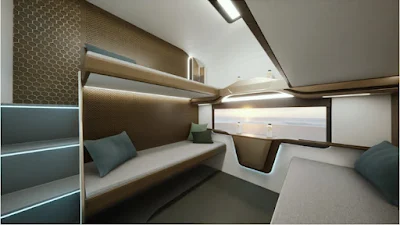Concept Train Vande Baharat (sleeper version) …Coming soon … early 2024 tweeted Ashwini Vaishnaw – Minister for Railways, Communications, Electronics & Information Technology, Government of India. He shared some eye catchy pictures on X (Twitter) today.
"Vande Bharat" Express trains were a significant development in India's railway infrastructure. These high-speed, semi-high-speed, or self-propelled trains were introduced to modernize India's rail network and offer a more comfortable and efficient travel experience for passengers. Please note that there may have been further developments and new trains introduced after my last update.
Here are some key
points about Vande Bharat Express trains:
Indigenously
Designed: Vande Bharat Express trains were designed and manufactured in
India, showcasing the country's engineering and manufacturing capabilities.
They were developed by the Integral Coach Factory (ICF) in Chennai.
Semi-High-Speed:
These trains were classified as semi-high-speed trains, capable of achieving
speeds of up to 160 km/h (99 mph) on certain sections of the railway tracks.
This allowed for faster and more efficient transportation between major cities.
Modern Amenities:
Vande Bharat Express trains were equipped with state-of-the-art amenities and
facilities. They offered features such as fully air-conditioned coaches,
spacious and comfortable seating, LED lighting, onboard Wi-Fi, modular toilets,
and automatic sliding doors.
Energy Efficiency:
One of the notable features of Vande Bharat Express trains was their
energy-efficient design. They used regenerative braking systems to recover
energy during braking, which was then used for powering lights and fans inside
the train. This made them more environmentally friendly.
Enhanced Safety:
Safety features like fire-resistant materials, anti-climbing features, and
emergency exit doors were integrated into the train design to ensure passenger
safety.
Routes:
Initially, Vande Bharat Express trains were introduced on key routes connecting
major Indian cities, such as the New Delhi-Varanasi route, Secunderabad -Tirupati
etc. The goal was to reduce travel time and provide a premium travel experience
on these popular routes.
Increased Passenger
Capacity: These trains were designed to accommodate more passengers
compared to traditional Indian trains, making them a viable option for
high-demand routes.
Make in India
Initiative: The Vande Bharat Express initiative was aligned with the Indian
government's "Make in India" campaign, promoting domestic
manufacturing and self-reliance in various sectors, including railways.
Success and
Expansion: The success of the initial Vande Bharat Express trains led to
plans for the introduction of more such trains on other prominent routes in
India. These trains were seen as a step toward transforming India's railway
system and enhancing the overall travel experience for passengers.





No comments:
Post a Comment